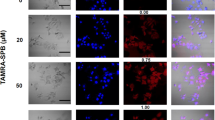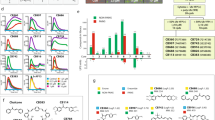Abstract
Adenovirus-mediated gene therapy of bladder diseases has been limited by the inability to transduce the urothelium successfully using adenoviral vectors. We have sought to identify agents that would increase adenovirus-mediated transgene expression in the bladder. We have utilized a rat model to screen compounds for their ability to enhance viral transgene expression in the rat bladder. Rats received intravesical administration of replication-deficient adenovirus (rAd) formulated in various agents, and transgene expression was evaluated after 48 h by determining the amount of lacZ expression in the luminal epithelium of the bladder. We report the identification of two different polyamides, each capable of dramatically increasing viral transgene expression in the bladder without causing detectable alteration of the umbrella cell layer of the urothelium. We have utilized a carcinogen-induced rat bladder tumor model to demonstrate that these polyamides are also capable of enhancing viral transgene expression in tumor tissue. The identification of these polyamides potentiates the use of adenovirus-mediated gene therapy for the treatment of superficial bladder cancer or other bladder diseases.
This is a preview of subscription content, access via your institution
Access options
Subscribe to this journal
Receive 12 print issues and online access
$259.00 per year
only $21.58 per issue
Buy this article
- Purchase on Springer Link
- Instant access to full article PDF
Prices may be subject to local taxes which are calculated during checkout






Similar content being viewed by others
References
Robbins PD, Ghivizzani SC . Viral vectors for gene therapy Trends Biotech 1998 16: 35–40
Morris BD et al. Adenoviral-mediated gene transfer to bladder in vivo J Urol 1994 152: 506–509
Bass C et al. Recombinant adenovirus-mediated gene transfer to genitourinary epithelium in vitro and in vivo Cancer Gene Ther 1995 2: 97–104
Lilly JD, Parsons CL . Bladder surface glycosaminoglycans is a human epithelial permeability barrier Surg Gynecol Obstet 1990 171: 493–496
Nickel JC . Relative efficacy of various exogenous glycosaminoglycans in providing a bladder surface permeability barrier J Urol 1998 160: 612–614
Engler H et al. Ethanol improves adenovirus mediated gene transfer and expression to the bladder epithelium of rodents Urology 1999 53: 1049–1053
Badalament R et al. Enhancement of bacillus Calmette–Guerin attachment to the urothelium by removal of the rabbit bladder mucin layer J Urol 1992 147: 482–485
Parsons DW, Grubb BR, Johnson LG, Boucher RC . Enhanced in vivo airway gene transfer via transient modification of host barrier properties with a surface-active agent Hum Gene Ther 1998 9: 2661–2672
Allen A, Flemstrom G, Garner A, Kivilaakso E . Gastroduodenal mucosal protection Physiol Rev 1993 73: 823–857
Koga K, Murakami M, Kawashima S . Contribution of hydrophobicity of nonionic detergents to membrane lipid fluidity and diisopyramide uptake by rat intestinal brush-border membrane vesicles Biol Pharm Bull 1997 20: 674–679
Valles AM, Boyer B, Tarone G, Thiery JP . Alpha 2 beta 1 integrin is required for the collagen and FGF-1 induced cell dispersion in a rat bladder carcinoma cell line Cell Adhes Commun 1996 4: 187–199
Masui T et al. p53 mutations in transitional cell carcinomas of the urinary bladder in rats treated with N-butyl-N-(4-hydroxybutyl)-nitrosamine Cancer Lett 1996 105: 105–112
Wills K et al. Development and characterization of recombinant adenoviruses encoding human p53 for gene therapy of cancer Hum Gene Ther 1994 5: 1079–1088
Gasser TC, Madsen PO . Influence of urological irrigation fluids on urothelial bacterial adherence Urol Res 1993 21: 401–405
Kaufman JE, Anderson K, Parsons CL . Inactivation of antiadherence effect of the bladder surface glycosaminoglycans as a possible mechanism for carcinogenesis Urology 1987 30: 255–258
Parsons CL . Prevention of urinary tract infection by the exogenous glycosaminoglycan sodium pentosanpolysulfate J Urol 1982 127: 167–169
Bergelson JM et al. Isolation of a common receptor for Coxsackie B viruses and adenoviruses 2 and 5 Science 1997 275: 1320–1323
Kovesdi I, Brough DE, Bruder JT, Wickham TJ . Adenoviral vectors for gene transfer Curr Opin Biotechnol 1997 8: 583–589
Nielsen LL, Maneval DC . p53 tumor suppressor gene therapy for cancer Cancer Gene Ther 1998 5: 52–63
Gonzalez-Zulueta M, Jones PA . Chapter 19. In: Vogelzang NJ, Scardino PT, Shipley WU, Coffey DS (eds) Comprehensive Textbook of Genitourinary Oncology Williams and Wilkins: New York 1996 314–325
Herr HW . Can p53 help select patients with invasive bladder cancer for bladder preservation? J Urol 1999 161: 33–35
Walters RW et al. Basolateral localization of fiber receptors limits adenovirus infection from the apical surface of airway epithelia J Biol Chem 1999 274: 10219–10226
Shabram PW et al. Analytical anion-exchange HPLC of recombinant type-5 adenovirus particles Hum Gene Ther 1997 8: 453–465
Hjelmeland LM, Klee WA, Osborne JC Jr . A new class of nonionic detergents with a gluconamide polar group Anal Biochem 1983 130: 485–490
Acknowledgements
We would like to thank Stephen Chang, PhD Scientific Director, Canji, Inc. for scientific advice, Ken Wills, PhD, Molecular Biology, Canji, Inc., and Beth Hutchins, PhD, Process Sciences, Canji, Inc. for providing the rAd constructs and Debbie Muilwijk for assistance with the development of the BBN rat tumor model.
Author information
Authors and Affiliations
Rights and permissions
About this article
Cite this article
Connor, R., Engler, H., Machemer, T. et al. Identification of polyamides that enhance adenovirus-mediated gene expression in the urothelium. Gene Ther 8, 41–48 (2001). https://doi.org/10.1038/sj.gt.3301348
Received:
Accepted:
Published:
Issue Date:
DOI: https://doi.org/10.1038/sj.gt.3301348



